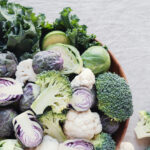Sulforaphane stops cancer and promotes detoxification
 (NaturalHealth365) According to Breastcancer.org, in 2023, an estimated 297,790 new cases of invasive breast cancer are expected to be diagnosed in U.S. women. One in 8 women – or 13 percent – will develop invasive breast cancer at some point in their lives. And cancer of all types constitutes the No.2 leading cause of death in the country – second only to heart disease. But, in this special report, you’ll discover how a powerful (anticancer) compound called sulforaphane can help protect your life.
(NaturalHealth365) According to Breastcancer.org, in 2023, an estimated 297,790 new cases of invasive breast cancer are expected to be diagnosed in U.S. women. One in 8 women – or 13 percent – will develop invasive breast cancer at some point in their lives. And cancer of all types constitutes the No.2 leading cause of death in the country – second only to heart disease. But, in this special report, you’ll discover how a powerful (anticancer) compound called sulforaphane can help protect your life.
Given these troubling statistics, it’s essential to understand that you CAN dramatically reduce your cancer risk by simply eating some common vegetables that contain sulforaphane.
Cruciferous vegetables contain lifesaving compounds
Study after study has shown that increased consumption of cruciferous vegetables – including broccoli, Brussels sprouts, cabbage, mustard greens, and kale – is strongly associated with reductions in mortality – and offers particular protection against cancers of the breast, prostate, bladder, and lung.
In fact, in a study published in the Journal of American Clinical Nutrition, the top 20 percent of cruciferous vegetable consumers reduced their risk of mortality from all diseases by 22 percent – almost a quarter.
And when it comes to protection against breast cancer, the picture is even brighter. Extensive epidemiological studies have shown that women who consume cruciferous vegetables daily slash their risk of breast cancer – in some cases, by up to 50 percent.
Sulforaphane from broccoli sprouts aggressively fights cancer at every stage
Researchers believe that the protection offered by cruciferous vegetables is mainly due to their content of sulforaphane, an organosulfate compound in the isothiocyanate group.
Extensive research has shown that sulforaphane kills cancer cells, reduces cancer risk, reduces inflammation that could trigger cancer, prevents DNA changes that can lead to cancer, and even deactivates an enzyme that converts procarcinogens into active carcinogens.
The highest concentration of sulforaphane can be obtained by eating foods that are rich in a sulforaphane precursor – a compound called glucoraphanin. Although Brussels sprouts, cabbage, watercress, and radishes all contain glucoraphanin, the real high-ringer in glucoraphanin content is broccoli – specifically, broccoli sprouts, which contain up to 100 times more of this vital precursor than mature broccoli.
Sulforaphane targets cancer at the cellular and genetic level
According to Dr. Rhonda Patrick, a biomedical scientist and expert on micronutrients and cancer, sulforaphane acts like a signaling molecule – activating dormant genes that produce chemopreventive enzymes.
Specifically, sulforaphane activates the NRF2 pathway, which affects the expression of over 200 genes – including those that promote antioxidant, anti-inflammatory, detoxifying, and cancer-fighting activity.
One of the cancer-fighting molecules triggered by sulforaphane is glutathione – the body’s ‘master antioxidant’ – which protects cells from the dangerous effects of oxidation and free radicals. Other genes activated by sulforaphane are tumor-suppressive genes and detoxifying genes, which help the body excrete carcinogens.
By activating a family of substances known as phase II detoxification enzymes, sulforaphane increases the excretion of benzene – a proven carcinogen found in tobacco smoke and automobile exhaust – by up to 61 percent.
Cruciferous vegetables’ healing powers have been known for thousands of years
Since ancient times, natural healers and herbalists have known of the beneficial and disease-fighting effects of cruciferous vegetables. Astonishingly, some even noted their ability to treat cancer – specifically, breast cancer.
Cato the Elder, a Roman historian who lived in the second century BC, wrote that cabbage not only eased “crapulence after exceeding wine consumption” – in a word, hangovers – but could also treat serious diseases such as cancer. Verbatim translations make it clear that Cato the Elder advocated treating “cancerous ulcers of the breast” by applying a cabbage leaf poultice.
Recent research validates ancient claims
Now, modern research is verifying this traditional wisdom. Scientists have found that sulforaphane causes apoptosis – or programmed suicide – in human breast cancer cells. In a study from Johns Hopkins, sulforaphane inhibited the growth of not one but four different kinds of human breast cancer cells.
In addition, clinical studies have shown that sulforaphane dramatically slows the rate at which prostate cancer develops. Prostate-specific androgen – or PSA – is a well-known cancer biomarker that can reflect the rate of growth.
In a double-blind, placebo-controlled, six-month-long study published in Cancer Prevention Research, 60 mg of sulforaphane a day from broccoli sprouts slowed the doubling rate of PSA by an amazing 86 percent.
How should I use sulforaphane to help protect against cancer?
Many studies have used amounts of sulforaphane ranging from 40 to 60 mg a day. According to Dr. Patrick, this amount can be roughly equaled by eating 140 grams of raw, fresh broccoli sprouts daily.
Broccoli sprouts can be easily grown by adding 2 tablespoons of broccoli sprouting seeds to a quart or Mason jar, covering them with a few inches of filtered water, capping the jar, and storing it in a warm, dark place overnight. Drain the water, then rinse the sprouts.
You can also consume glucoraphanin and sulforaphane by eating Brussels sprouts, cabbage, mustard greens, and watercress.
However, if you are cooking cruciferous vegetables, you should avoid prolonged heating and boiling, which inactivates the enzyme that turns glucoraphanin into sulforaphane. For maximum health benefit, opt for very light steaming – no more than 3 to 4 minutes – instead.
Sources for this article include:



